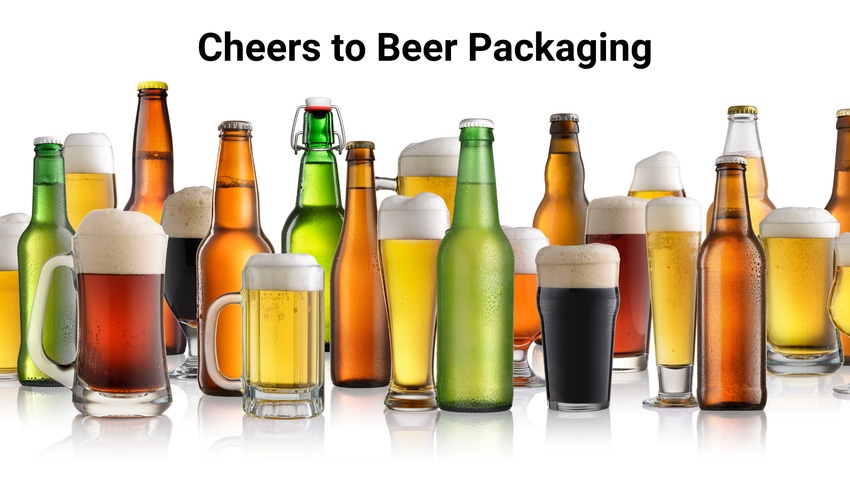Beer Brands Wield a Secret Weapon
Breweries turn to novel packaging and consumer-engaging options to boost beer sales.

At a Glance
- Global beer packaging market to hit $28.7 billion by 2024
- Craft beer boom drives demand for innovative, smart packaging solutions
- Future beer packaging trends shaped by culture, health, and sustainability
Novel packaging has long been a dynamic way to capture consumer attention at retail. Turns out, it’s also cheers-worthy in the overcrowded beer segment, too.
A study from Future Market Insights (FMI) found the global market for beer packaging on track to reach a $28.7 billion valuation by the end of 2024, up from $27.6 billion at the end of 2023. What’s more, a projected 3.5% CAGR over the next 10 years will launch the segment worth to about $40.5 billion by 2034. Regionally, the market in China is expected to expand at a CAGR of 5.3% through 2034.
Disposable incomes are increasing, as is the demand for craft beers and single-serve packaging. According to FMI researchers, a top factor contributing to the malty sales leap is packaging, and it’s being influenced by a variety of factors. For starters, sophisticated and high-quality packaging is sought after by premium and luxury alcoholic beverages to reflect the exclusivity and value of the product.
Cultural and demographic factors, such as changing tastes and preferences among younger generations, are also influencing shifts in beer packaging trends. As brewers work to better understand their target demographic, they’re increasingly adapting their packaging strategies too.
And with specialty stores, online retail, brewery taprooms and festivals adding new facets to longstanding traditional sales venues, packaging that’s suitable for different retail environments is another important consideration. The growth of ecommerce and direct-to-consumer sales channels are making the demand for more robust and protectively designed beer packaging increasingly critical.
Aluminum cans and time-tested glass round bottles (the latter of which FMI projects will account for 41.3% of the beer packaging segment) are time-tested solutions that have been hard to beat as reliable and recyclable primary packaging for brew. In addition to customized, attention-grabbing label graphics, FMI says brewers are turning to “smart packaging features” to enhance the collective sipping experience.
Specialty, craft beer packaging considerations.
Specialty beer formulations present unique challenges for which packaging can assist. For instance, unlike soft drinks, craft beers and specialty brews can be sensitive to temperature fluctuations, leading brewers to seek packaging solutions with built-in temperature control features to help maintain the quality of the product during transportation and storage.
Ismail Sutaria, lead consultant for packaging and materials at FMI, says ingredient-led packaging is emerging as a particularly intriguing area of importance, especially as the legal acceptance of cannabis continues to grow.
“In regions where cannabis-infused beverages are legal, the integration of cannabis into beer products may open up new packaging considerations, such as child-resistant features and clear labeling for regulatory compliance,” he says.
Beer packaging is also a vehicle for communicating nutritional information and highlighting ingredients that appeal to consumers with a health and wellness mindset. The FMI study indicates that packaging that aligns with health-conscious consumer preferences may find opportunities in the market.
That means adherence to regulatory requirements, especially as it relates to labeling and environmental concerns. It also means that packaging must emphasize transparency to help build consumer trust. Likewise, the international expansion of beer brands has compelled packaging changes that can withstand different regional climates and transportation conditions.
In fact, FMI adds, region-specific packaging designs that incorporate cultural aesthetics or pay homage to local traditions can be a successful packaging strategy that helps a brand resonate well with specific consumer segments.
Another round of beer packaging options, technologies.
Resealable packaging is another avenue of interest. This is a great option for larger beer containers like bottles and cans and caters to consumers who may want savor their suds over multiple sipping occasions versus consuming an entire container in one sitting.
Taking a cue from smart labels and quick-response (QR) codes, temperature indicators and near-field communication tags are other ways brewers are enhancing the consumer experience. These innovations help to provide real-time information about the status of the product and allow for improved and interactive consumer engagements with the products and the breweries that produced them.
Similarly, packaging also helps enhance the in-store experience, whether through visually appealing displays or interactive elements, influencing consumer purchasing decisions at the point of sale. Packaging that incorporates interactive elements, such as augmented reality features or QR codes leading to engaging content, can enhance consumer interaction with the brand and provide a unique experience.
Festivals and similar beer-related events can benefit from collapsible or flat-pack configurations for their storage and transportation efficiency advantages where space can be a constraint. The ongoing bans on single-use plastic have given rise to paper-based and compostable packaging innovations in many market segments. While crafty brewers have found ways to replace plastic carriers with paper-based carriers, the paper-based packaging options for the beer industry are still in a relative infancy.
Two caveats noted by FMI are the costs associated with implementing environmentally friendly packaging or innovative technologies can be substantial. Breweries, especially smaller ones, might face financial constraints in adopting new packaging solutions. Secondly, consumers may resist changes in packaging formats or materials, especially if it affects their perception of the brand or the convenience of the product.
Next, the beer market is forecast to experience accelerated growth from now until 2034. FMI says the beer industry is drawing packaging inspiration from trends in the wine, spirit, and soft drink segments, as well as from non-beverage categories, to help create unique beer packaging design solutions with an eye on the future.
Related links
Coors Light’s Digitally Printed Lights Out Beer Can
Yuengling Brewery Redeploys Camo Cans Packaging for Beer
About the Author(s)
You May Also Like




